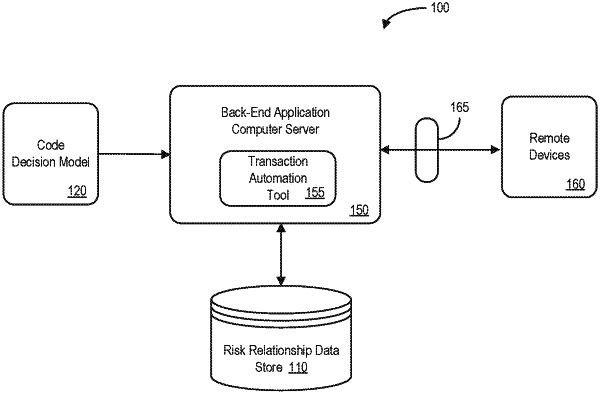| CPC G16H 50/30 (2018.01) [G16H 50/20 (2018.01); G16H 70/60 (2018.01)] | 18 Claims |

|
1. A system to provide a risk relationship resource allocation tool via a back-end application computer server of an enterprise, comprising:
(a) a risk relationship data store containing electronic records that represent a plurality of transactions associated with requested resource allocations between the enterprise and a plurality of entities, wherein each electronic record includes an electronic record identifier and at least one code representing a medical condition;
(b) the back-end application computer server, coupled to the risk relationship data store, programmed to:
(i) receive an indication of a selected requested resource allocation transaction between the enterprise and an entity;
(ii) retrieve, from the risk relationship data store, the electronic record associated with the selected requested resource allocation transaction, including the at least one code representing a medical condition;
(iii) execute a predictive model trained with a machine learning process and business rules based on the at least one code to generate a likelihood of acceptance score for the selected requested resource allocation transaction, wherein the likelihood of acceptance score predicts a likelihood the at least one code is approved;
(iv) assign the selected requested resource allocation transaction to a recommendation category based on the likelihood of acceptance score, wherein the assigned recommendation category represents automatic approval of the code thereby reducing a number of electronic messages being transmitted via a distributed communication network;
(v) automatically route the selected requested resource allocation transaction to a claim handler device based on the assigned recommendation category;
(vi) generate a “next best action” for the selected requested resource allocation transaction based on output of multiple machine learning assets;
(vii) transmit the “next best action”, wherein a summary associated with the code and the “next best action” is displayed on a user interface of the claim handler device;
(viii) generate a pop-up window on the user interface in response to selection of the code, wherein the pop-up window provides additional information that is not available without the selection to reduce a number of electronic messages transmitted via the distributed communication network; and
(c) a communication port coupled to the back-end application computer server to facilitate a transmission of data with a remote device to support a graphical interactive user interface display and the distributed communication network, the interactive user interface display providing resource allocation data including the likelihood of acceptance score and the recommendation category.
|